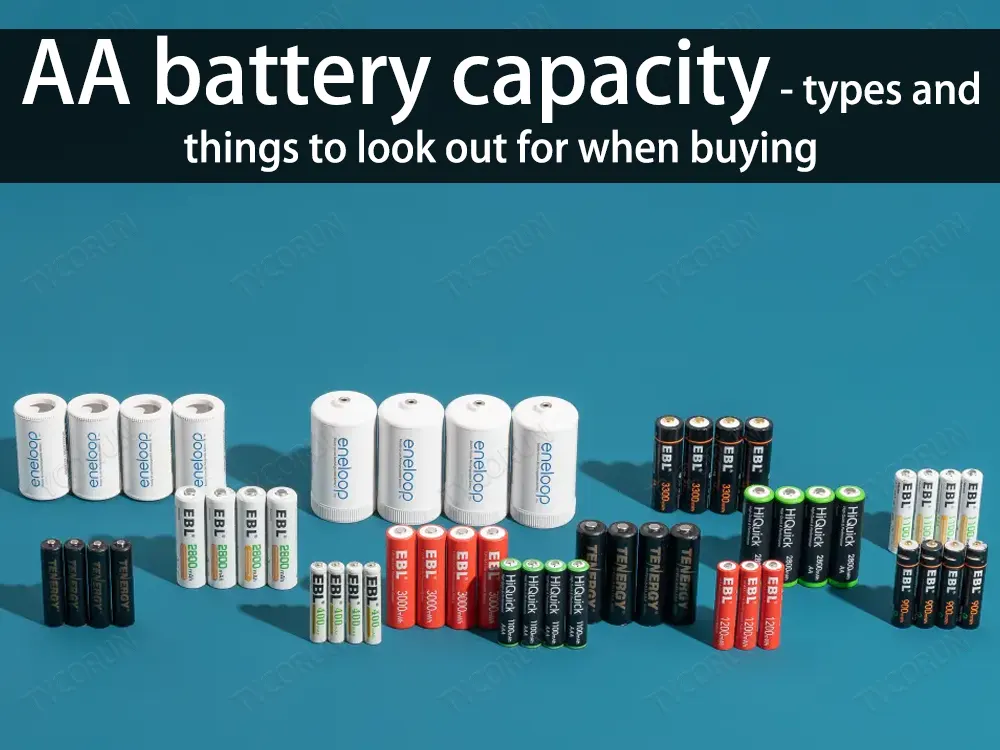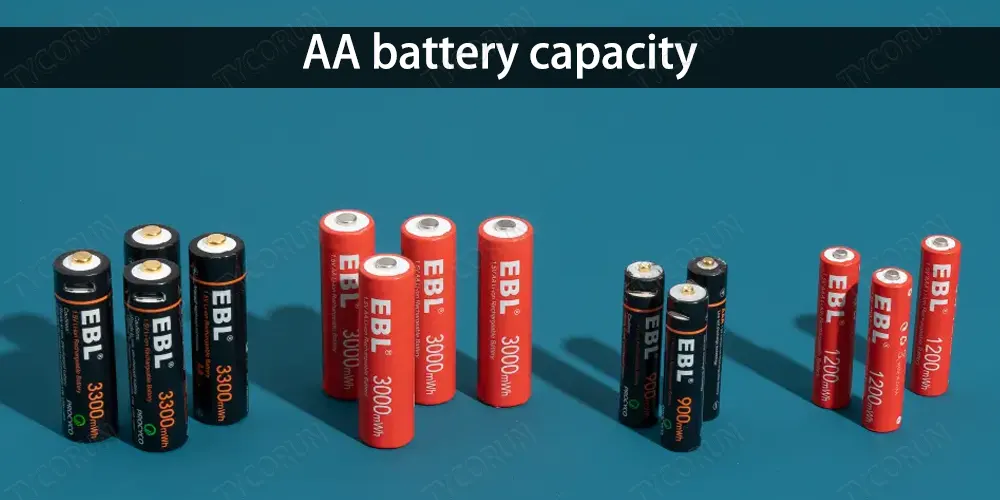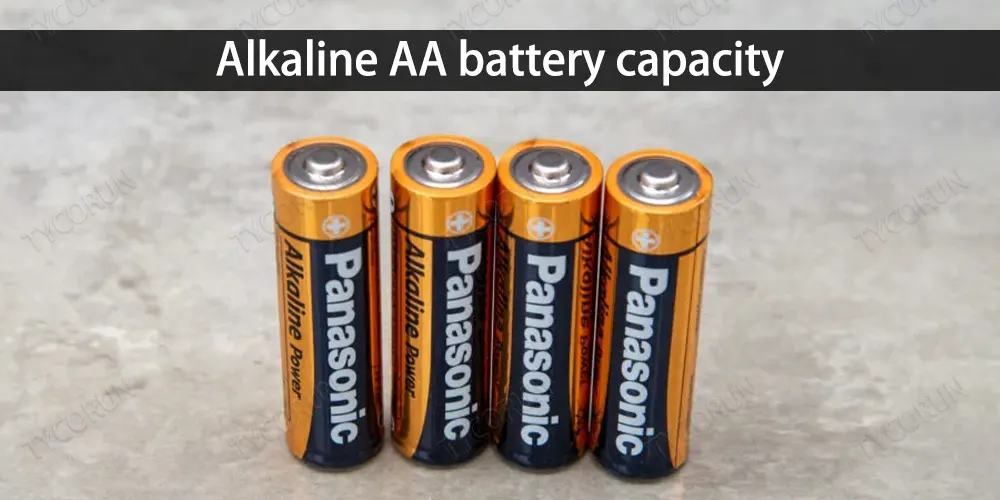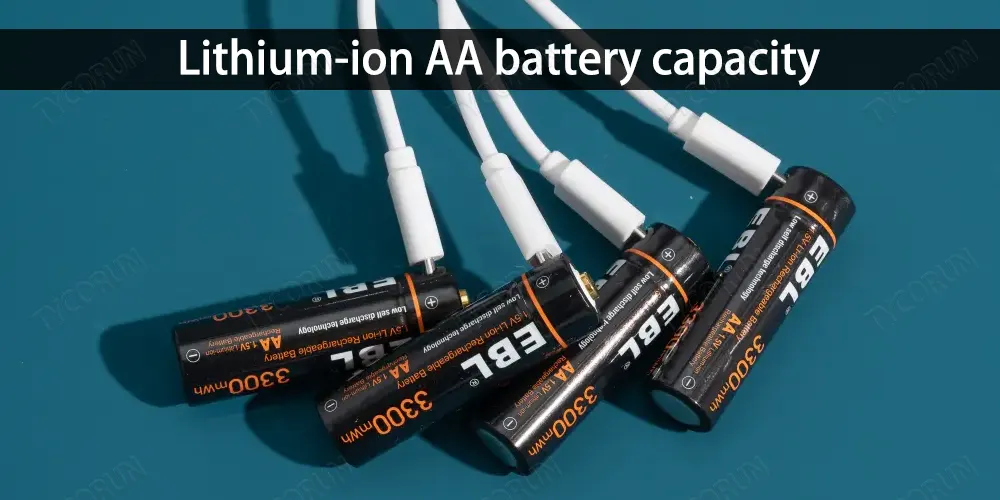Home » lithium ion battery knowledge » AA battery capacity – types and things to look out for when buying
AA battery capacity - types and things to look out for when buying

What does AA battery capacity mean?
So that you can properly understand what an AA battery capacity means, we will split the terms into parts. The first part is the “AA” term in front of AA battery capacity, and this actually denotes the battery model.
These models are called the 5th battery, with a general size of 14mm in diameter and 49mm in height. The capacity is measured in milliampere hours (mAh) to tell you how many milliamperes of current a battery can provide over a specific period.
A general rule of thumb with a battery’s capacity is that the higher the mAh, the longer it will last.
Are all AA battery capacity the same?
All AA battery capacities are not the same because they have distinct chemistry and discharge conditions; their capacities vary depending on these factors.
For example, alkaline batteries are about 1100-1800 mAh, zinc-carbon batteries are between 400-900 mAh, and lithium batteries usually have up to 3000 mAh.
These numbers could change, though, depending on the temperature, the cut-off voltage, and how much current the electronic device uses.
How do I know the AA battery capacity?
In most cases, an AA battery capacity is always written on the print of the battery.
Suppose you can’t find it on the battery. You can use a multimeter that can measure current and voltage or through a battery test to know the capacity of the AA battery.
To determine which battery has a larger capacity, you can also compare the discharge times of various batteries under the same circumstances.
How AA battery capacity is measured?
You’ll need an instrument that can measure the battery’s current and voltage during discharge to deduce an AA battery capacity. Battery testers or multimeters are the standard tools you can use to measure the capacity properly.
You should also be aware of the battery’s cut-off voltage, which is the lowest voltage at which the device can work. Most devices, for example, use an AA battery cut-off voltage of 0.8 V.
You must connect the battery to your preferred measurement device and measure the current and voltage to determine the capacity. The next thing is to multiply the current and voltage to determine the power in watts.
You keep measuring the power until the voltage falls below the cut-off voltage. To determine the energy in watt-hours (Wh), you add all the power measurements throughout the time together. To calculate the capacity in mAh, divide the energy by the typical voltage.
Introduce common AA battery capacity
Zinc-carbon AA battery capacity
Zinc-carbon batteries are the most affordable and readily available type of AA battery. They have a low capacity of 400 to 900 mAh and a low voltage of 1.5 V, which rapidly declines the moment you start discharging them.
This makes them suitable for low-power devices like clocks and radios but not ideal for high-power equipment like digital cameras and flashlights. They also have a short shelf life of roughly 2 years and may leak corrosive substances if poorly stored. Zinc-carbon batteries are disposable batteries.
Alkaline AA battery capacity
Alkaline batteries are the most common and popular type of AA batteries. They feature a reasonable capacity of 1800 to 2700 mAh and a constant voltage of 1.5 V that gradually declines as they discharge. They work on most devices, particularly high-drain equipment like digital cameras and spotlights.
They also have a longer shelf life of 5 to 10 years and are less susceptible to leaking than zinc-carbon batteries. They are more expensive than zinc-carbon batteries and are also not rechargeable.
Nickel-cadmium AA battery capacity
Nickel-cadmium batteries are the oldest and most obsolete type of AA batteries. They have a low capacity of 600 to 1000 mAh and a low voltage of 1.2 V, which gradually declines as they discharge.
They are appropriate for low-power devices like clocks and radios but unsuitable for high-power equipment like digital cameras and flashlights.
They also have a limited shelf life of roughly 3 years and suffer from memory effects, which means that they’ll lose their capacity if you don’t empty them fully before recharging. They are also poisonous and hazardous to the environment.
Nickel-metal hydride AA battery capacity
Nickel-metal hydride batteries have a high capacity of 500 to 800 mAh and a stable voltage of 1.2 V that slightly drops as you discharge them. They are appropriate for most devices, particularly high-drain equipment like digital cameras and spotlights.
However, they cost more than alkaline batteries and have high self-discharge, which means that they gradually lose their charge even when they are not in use. Additionally, they have a shorter cycle life than NiCd batteries.
Lithium-ion AA battery capacity
Lithium-ion batteries are the most recent and technologically advanced rechargeable AA batteries. With a voltage range of 3.2v-3.6v, these AA lithium batteries pack a punch that can power device for longer periods of time.
Moreover, the rechargeable nature adds a lot of convenience, allowing for multiple uses and reducing the need for frequent replacements, which ultimately saves money in the long run.
Therefore, lithium AA batteries are an excellent investment for anyone who wants to ensure their devices have the power they need to operate effectively and efficiently.
AA battery capacity vs 18650 battery capacity
Even though the AA and 18650 batteries can power many devices that supports the usage of a cylindrical battery, there are still differences between them.
The first noticeable difference is their size, with 18650 batteries having 18mm x 65mm dimensions and AA batteries measuring 14.5mm x 50.5mm. This automatically means that 18650 batteries have a higher energy capacity than AA batteries but take up more space and might not fit in all electric devices.
But an AA battery has a lower capacity than an 18650 battery. Depending on chemistry and quality, an AA battery capacity ranges from 600 to 3500 mAh, but a 18650 battery capacity ranges from 1800 to 5000 mAh. This implies that 18650 batteries have a longer lifespan than AA cells, but they also take longer to charge.
Factors that affect AA battery capacity
Temperature
This factor impacts an AA battery’s capacity regardless of its level. Both high temperature and low temperature will affect the normal capacity of the battery.
This is because a battery’s internal resistance and chemical reactions are accelerated by high temperatures, decreasing its effectiveness and useful life.
Age
Everything always declines with time, and AA batteries are no exception. Their capacity falls as they get older due to several causes, including corrosion, oxidation, electrolyte depletion, and internal short circuits. The type and quality of the battery, as well as the storage and usage conditions, all play a role in how quickly they lose capacity.
Depth of Discharge
Depth of discharge (DoD), which generally refers to the percentage of the capacity used during a discharge cycle, is another aspect that affects an AA battery’s capacity. For example, the DoD of a battery with a 2000 mAh capacity that has been depleted to 1000 mAh is 50%.
The deeper the discharge, the lower the remaining capacity and the shorter the battery’s cycle life. This is because deep discharges cause more stress and damage to the battery electrodes and electrolytes, which reduce their ability to hold and deliver charge.
Therefore, you should not fully discharge a battery and always recharge it before it reaches a low voltage level.
Charge Rate
The charge rate is the current or power utilized to charge a battery, and it is typically stated as a fraction or multiple of the battery capacity. For example, the charge rate of a 2000 mAh battery when you charge it at 1000 mA is 0.5C.
The higher the charge rate, the faster the charging time. Rapid charging degrades the battery’s stability and efficiency by increasing heat generation and chemical deterioration. Using a slow or moderate charge rate fit for the battery’s size and type is recommended.
What type of AA battery has the largest capacity? Why?
Due to its higher energy density and lower self-discharge rate compared to other battery types like alkaline, zinc-carbon, nickel-cadmium, and nickel-metal hydride, lithium AA batteries have the largest capacity of any AA battery type.
According to some sources, a lithium AA battery can have a capacity of 3000 mAh. This is much higher than the average capacity of alkaline batteries, around 2000 mAh, or the average capacity of Ni-MH batteries, about 800 mAh.
Is the bigger the AA battery capacity, the better?
This is not always the case because what is better depends on whether the battery’s capacity suits your needs and preferences.
A bigger AA battery capacity means that the battery can store and deliver more energy, which can be useful for devices that require a lot of power or long run times.
However, a bigger AA battery capacity can also indicate a higher price or a longer charging time. As a result, you should select the AA battery size most appropriate for device and usage.
How do I calculate the required AA battery capacity for my device?
For you to know how many AA batteries the device needs, you must know two things. The average current draw and the required run duration of the equipment are these two crucial factors.
Device’s current draw, often expressed in milliamperes (mA), is the electric charge that passes through it per unit of time. Device’s “run time,” often expressed in hours (h), is the amount of time you want it to continue working until the battery dies.
The formula to calculate the required AA battery capacity is:
Capacity (mAh) = Current (mA) x Time (h)
For example if the electric device typically consumes 200 mA and you want it to operate for 15 hours, you will need an AA battery with a minimum capacity of:
Capacity = 200 mA x 15 hours = 3000 mAh.
This is merely an approximate estimate, though, as the actual capacity of an AA battery can change based on some variables. The battery type, discharge rate, temperature, and battery age are a few of these variables.
Thus, we advise you to use an AA battery for device with a safety margin of at least 20%.
Conclusion
When you select the right capacity, AA batteries are a handy power source for various electronic devices.
But in order to choose the best for your requirements, you need to understand AA batteries’ types, voltages, capacities, and dimensions.
To maximize AA batteries’ use, you need to be aware of the elements that determine their capacity. Contact us right now to get the best AA battery capacity!





























